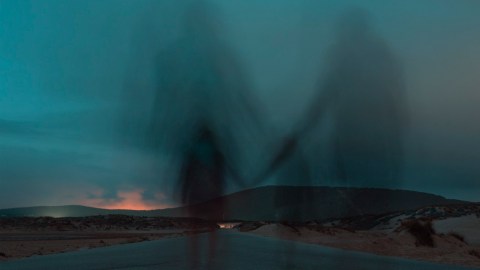Why do we believe photographs capture spirits?

JR Korpa on Unsplash
In July 2016, a fatal motorcycle crash in Kentucky received more attention than usual when a random passerby snapped a photo. In his caption, Saul Vasquez directs your attention to an ominous shadow, which he believes to be the deceased’s soul leaving his body.
Although the motorcyclist didn’t die until reaching the hospital, the photo has been shared over 15,000 times. Facebook comments verify the belief that the blurry spot is, indeed, those missing 21 grams of ethereal spirit circulating above the living.
Capturing wily souls on film is as old as photography itself. In the middle of the 19th-century a Boston jeweler named William Mumler eyed a feminine ghost in his self-portrait. Initially he suspected it to be a double exposure; his friends convinced him otherwise. Mumler, excited by the potential windfall, closed down his jewelry shop to become the first ‘spirit photographer‘.
Mumler raked it in until eagled-eyed customers noticed that the spirits looked remarkably like people who had previously sat for him. He avoided prosecution for fraud in court, though his reputation did not. Nevertheless a cottage industry was born; today’s incarnation is known as Kirlian photography.
Russian photographer Semyon Kirlian, a student of electricity, was influenced by Nikola Tesla. The great engineer and inventor had a passion for corona discharge photography, an electrical discharge that can be captured on film. Alongside his wife, Kirlian developed a photographic technique that promised to identify ones aura. This technique is still used today as evidence of the ethereal world.
The spirit world was in high demand during the early 20th century. Returning to Massachusetts, physician Duncan ‘Om’ MacDougall decided to weigh the bodies of the dying. He concluded the weight of the soul to be 21 grams (his term was “three-fourths of an ounce”). Sadly, when he later experimented on dogs, he found no meaningful mass loss—canines are apparently soul-less.
Another physician, Augustus P. Clarke, was not impressed. In 1907 he conducted his own research. Psychologist Richard Wiseman writes,
Clarke noted that at the time of death there is a sudden rise in body temperature due to the lungs no longer cooling the blood, and the subsequent rise in sweating could easily account for MacDougall’s missing 21 grams. Clarke also pointed out that dogs do not have sweat glands (thus the endless panting) and so it is not surprising that their weight did not undergo a rapid change when they died.
Humans are fascinated by things that don’t exist—Jesus in a grilled cheese; the Loch Ness monster; Yeti—often at the expense of what does. Seeing what isn’t there is not evidence of the spirit world, though it does offer insight into human vision and beliefs. One of the most famous examples was invented by neuroscientist VS Ramachandran with his work on amputees.
When someone loses a limb—let’s say an arm—they often ‘feel’ it after. This can be excruciating, and not only emotionally: patients claim a searing physical pain thanks to the brain continuing to fire its signals. Ramachandran developed a mirror box, which ‘showed’ the amputee their other arm, tricking their brain into believing the amputated arm still existed. In many cases the illusion works. When the person watches their mirrored arm move, the pain disappears.
Ramachandran notes that such findings offer us incredible insight into the inner workings of our brain. He also writes that it makes some uncomfortable, as it overturns long-held assumptions about the imagined being inside our being.
Take out of body experiences. Regardless of the soul’s ‘weight,’ many have witnessed their soul float away (or, more often, watch their body while on the ceiling). Nearly a decade ago one British researcher figured out how to recreate an out of body experience in the lab. Even though participants knew the experience was an illusion, their bodies acted as if it were real.
In some ways it is real, in that how we view reality dictates what we believe. Soul chasers criticize the ‘mechanical workings’ of researchers, but Ramachandran says they have it backwards. Nothing is more liberating than understanding how we work, which has the added benefit of knocking our gigantic egos down a peg.
Far from being humiliating, this idea is ennobling, I think. Science—cosmology, evolution and especially the brain sciences—is telling us that we have no privileged position in the universe and that our sense of having a private nonmaterial soul ‘watching the world’ is really an illusion … Once you realize that far from being a spectator, you are in fact part of the eternal ebb and flow of events in the cosmos, this realization is very liberating.
Ramachandran concludes that coming to terms with how our brains operate adds a much-needed sense of humility to our lives. When we stop tricking ourselves into contemplating what our ‘soul’ needs, we observe what our planet and communities actually need. The veil torn off, progress is possible. As it turns out, nine of out ten dogs agree.
—
Derek Beres is working on his new book, Whole Motion: Training Your Brain and Body For Optimal Health (Carrel/Skyhorse, Spring 2017). He is based in Los Angeles. Stay in touch @derekberes.





